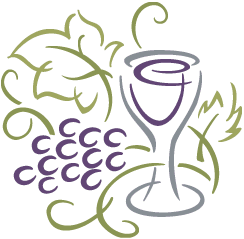Tuesday, June 20, 2006
 The Grape Geek
The Grape Geek
Well, kindred wine drinkers, I recently joined Steve DeLong's Wine Century Club. It's a tiny organization whose members have tasted at least 100 grapes. I'm privileged to be in such an august group, including members from places like Brazil, England, Portugal, Georgia (the Caucasus republic, not the birthplace of Julia Roberts) and the most exotic of locales, Canada.
In honor of my membership, I've decided to start an occasional visit to one of the 155 different grapes I've tried so far.
Trust me, I'm not bragging. Yes, I know, I'm a grape geek. I'll admit my social life amounts to going to a lot of wine tastings. But when you average it out over my entire wine career - a whopping 4 years - that's only 38.75 different grapes a year. I really do have a social life. Really!
I do!
Still not buying it? Oh well, here's the first episode of The Grape Geek:
TANNAT
 Vitals
VitalsColor - Red
Dry or Sweet - Dry
Body - Full
Fruit - Blueberry, Blackberry, Black Currant
Other Flavors - Roasted Coffee, Raw Cocoa, Damp Earth
Tannin - High
Acidity - High
Food Pairing - Buffalo, Beef, Lamb, Venison, Elk, Aged Cheeses
Aging potential - medium to high -Old World wines, 7-10 years; New world less
Old World Tannat
Tannat is originally a French grape, found in 3 primary areas: Cahors, Madiran and Irouleguy. Old world Tannat generally doesn't get enough sun in France to fully ripen, so you have to add other grapes to round out the wines. Old world Tannat will be tannic, rustic and very bold. Cahors is known for its "black wine," a wine that must be at least 70% Malbec. The remainder of the wine may be up to 30% from a blend of Merlot, Tannat or both. The wines are powerful, tannic and rich with a hint of black fruit flavor and violet aromas. They will age well, some for 20 years.
In Madiran, an appellation near Bergerac, almost due east of Bordeaux, Tannat is the primary grape in the mix. Madiran wines may be up to 40% Tannat, but also may be blended with Merlot, Cabernet Sauvignon, Cabernet France and Malbec. You'll rarely see Madiran that's made with 100% Tannat, except in the ripest of years. If you've tasted the Bonny Doon wine called Heart of Darkness, you know how expressive Madiran can be. Look for a wine by Chateau Montus as well. Bring a knife and fork, you'll need it and not just for the steak on the menu.
Irouleguy is a little known region, even in France, a place riddled with tiny, hideaway appellations. It sits up near the Spanish border, in Basque country, a region with some of the tastiest and most interesting food in the world. In this part of the Old World, the wine must be at least 50% Tannat, with Cabernet Sauvignon and Cabernet Franc making up the other 50%. I've only seen one Irouleguy in my wine travels. The producer? The tongue-tangling Domaine Arretxea.
Detective Story
Unless you live in a major metropolitan area like New York, Washington DC or Los Angeles, it'll be like finding a needle in a haystack of needles to get a bottle of one of these appellations (with the exception of the Bonny Doon Madiran). If you want to try an Old World wine with Tannat in it, then start with Cahors. That's the one you will most likely find, with other Madiran running a close second. Good luck with the Irouleguy.
Tannat in the New World
You're most likely to find Tannat as a varietal wine (a wine made with only one grape) in South America, namely in Argentina, where it - like most wines there - is grown at high altitude. In France, it's usually used as a blending wine because there isn't sufficient sunlight for the grape to achieve full ripeness. The Argentinian Andes, however, offer both plentiful sunlight and cool night and morning temperatures. Sun gives the grapes loads of fruit flavor, and cool climate ensure the grapes have enough acid to balance the fruit.
There are other areas trying to trade on the unique characteristics of Tannat, specifically Brazil and Uruguay. I've had a couple of Brazilian Tannats. One was amazing - rich, smooth and, well, absolutely unavailable - like all the women I'm interested in lately. The other, not so much. No Uruguayan Tannat yet, but I read it's the grape that will put Uruguay on the wine map.
Let's see if you can locate Tannat on your wine atlas. Try this one:
2003 Don Rodolfo Vina Cornejo Costas Tannat Cafayate Valley Salta ($14.49)
One last thing. Anything you'd like me to write about? Put it on my brand new tagboard at right!
Mark


4 Comments:
Hey, I like this theme... and it gives you 150 or so more post topics too!
But cover some sweet grapes too? Pretty please... just for me? ;)
Hey anonymous -
Make sure you check the next Friday wines. I'm going to recommend a good sweet wine then.
Mark
Wine-o -
Hadn't thought of that. But I generally will try and find at least one label you can look for. Thanks for the suggestion.
Alxq -
I wish I could say I was that good at blind tasting. Some of those people can tell who made the wines by tasting them. Suffice it to say, I'm *not* one of them. Blind indentification takes lots of practice and discipline.
Post a Comment
<< Home